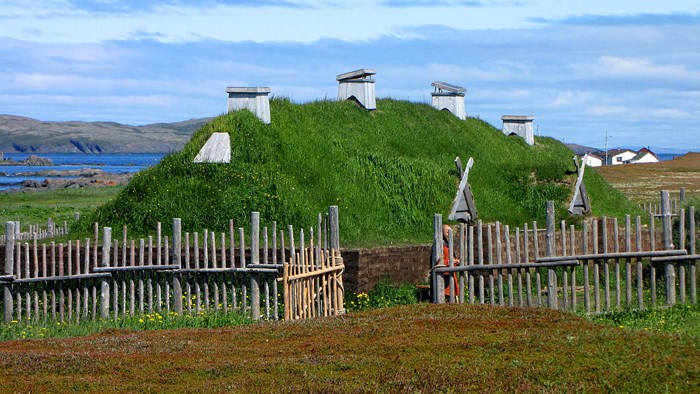In fourteen hundred ninety-two, Columbus sailed the ocean blue… So starts the poem from which American (and Canadian) children learned the beginnings of North American history for generations.
Even today, the Christopher Columbus “discoverer of America” mythology is one of the most persistent perceptions of North Americans and likely Europeans.
There is no question, of course, that the arrival of the Niña, the Pinta and the Santa Maria in the Bahamas in 1492 was the leading edge of European expansionism that would shape what the Americas are today through conquest and genocide.
There is also no question a Eurocentric view of history suits the narrative of “old stock” immigrants that we have the inherent right to benefit preferentially from the riches of our adopted homeland.
The history of human migration, though, is more complex and controversial.
To start with, Indigenous people of the Americas are not indigenous. That is to say, the people we now refer to as First Nations here and Native Americans in the United states did not originate on the American continents. All humans on the planet today are of one species, Homo sapiens, which evolved in Africa approximately 200,000 years ago.
The oldest confirmed human artifact found in North America dates to approximately 16,000 years ago. So far, South American evidence is younger. While there are still uncertainties in the details, the broader picture provides evidence our forebears left Africa 50,000 years ago spreading north then east and west.
Western expansion was stopped by the Atlantic Ocean, but Asians were able to cross into North America, and spread south via the Malay and Indonesian archipelagos into the South Pacific (Australia, Melanesia, Micronesia, Polynesia).
There is some evidence of pre-Columbian contact between Polynesian and South American peoples. Most researchers that buy this contention think the contact was initiated by Polynesians headed east, but the famous Kon Tiki expedition sought to prove it was the other way around. There remains a good deal of dispute about that.
The Taíno people, who were the first “Americans” Columbus encountered had settled the islands about 2,500 years ago from South America.
The point here is that, from the point of view of humans as a species, Columbus did not discover America--interestingly he never even set foot on what is now the continental United States, but Columbus day remains a national holiday in that country. In fact, even in a European context, Columbus was beaten to American shores by 500 years.
There is no dispute that the Norse traveled to (perhaps as far south as present-day New York City), and even settled, parts of North America starting in the late 10th and early 11th centuries. Although written accounts of these travels have existed since that time, they were not widely known until 1837 when Carl Christian Rafn, a Danish historian, resurrected the “Sagas of the Icelanders, which had been passed down by oral tradition and transcribed to written form in the 13th and 14th centuries. By the 19th century, however, these were legends for which there was no physical proof because Norse settlements in the “new world” did not become permanent.
That changed in the early 1960s when Anne and Helge Ingstad, a Norwegian archaeologist/author wife-husband team, excavated a Norse settlement at L’Anse aux Meadows at the very northern tip of Newfoundland.
Now, there is possibly more evidence. Last week, Sarah Parcak, a professor of anthropology at the University of Alabama and pioneer in using satellite imagery for archaeological research, announced she had found possible evidence of a Norse presence on the other end of the island at Point Rosee.
Media reports of the discovery of another Norse settlement in Newfoundland may be overstated.
“If it is Norse, the most we can say right now is that it’s a small farm or perhaps a temporary winter camp,” Parcak said. She plans to return this summer to do further excavation.
A documentary on last summer’s work airs tonight on PBS.
There is another fascinated sidebar to this story. One of the tragic consequences of post-Columbian European hegemony in the Americas was the extinction of Newfoundland’s Beothuk First Nation.
The Norse also interacted with the Beothuk, oft violently, but sometimes peacefully.
In 2010, National Geographic published genetic research that suggests Beothuk DNA may live on in modern Europeans.
In a study of mitochondrial DNA (a type of DNA only passed from mother to child) scientists found 80 living Icelanders who exhibit a genetic variation mostly found in Aboriginal North Americans. The best explanation for this genetic marker is that Vikings from the 11th century brought a Beothuk woman with them back from Newfoundland.
All of the 80 subjects descend from four women born in the early 1700s. Prior to 1700, Iceland had little contact with the outside world. Also, one of the four lineages exhibits a genetic mutation that would have taken centuries to occur, according to mtDNA experts. And the variation does not occur in Inuit peoples whom the Norse had much contact with through their long history of colonizing Greenland.
This all points to a single common ancestor of Indigenous North America origin, researchers believe.
Human history is so vast and fascinating and the great thing is, as much as we already know, there is almost certainly still way more that we have left to discover one site at a time.




